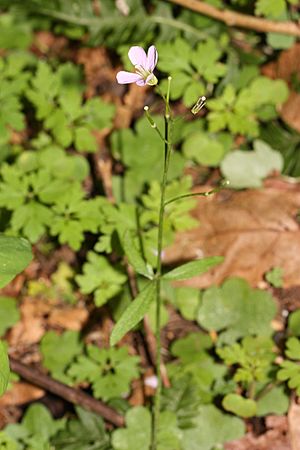Nuttall's toothwort facts for kids
Cardamine nuttallii is a type of wild flower often called Nuttall's toothwort. It grows naturally in western North America, from British Columbia in Canada all the way down to California in the United States. You can find it in wet places in the mountains.
Quick facts for kids Nuttall's toothwort |
|
|---|---|
 |
|
| Scientific classification | |
| Genus: |
Cardamine
|
| Species: |
nuttallii
|
What is Nuttall's Toothwort?
Cardamine nuttallii is a perennial herb. This means it's a plant that lives for more than two years. It grows from a small, white underground stem called a rhizome. Think of a rhizome like a special root that helps the plant spread.
The plant has a thin stem that doesn't branch out. It usually grows to be less than 20 centimeters (about 8 inches) tall. Its leaves can be smooth or have small bumps along their edges. Sometimes, the leaves are even divided into a few smaller parts.
The plant's flowers grow in a cluster called an inflorescence. There are usually several flowers, and they can be pale purple, pink, or sometimes white. Each petal is more than a centimeter long. After the flowers bloom, the plant produces a long, thin fruit called a silique. This fruit can be up to 4 centimeters (about 1.5 inches) long.
Different Kinds of Nuttall's Toothwort
There are four different types, or varieties, of Cardamine nuttallii. One rare type is called Cardamine nuttallii var. gemmata. This variety is endemic to certain areas. This means it only grows naturally in the redwood forests of northern California and southern Oregon.

